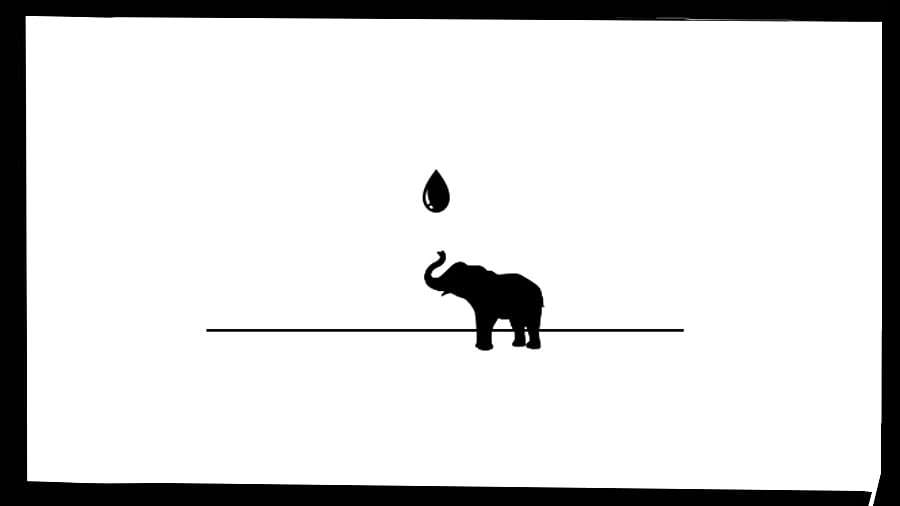
Credit: DH ILLUSTRATION
Recently, a couple of elephants died in Karnataka, and the cause of death was attributed to dehydration. These deaths garnered substantial media attention and public sympathy. This year, Karnataka is experiencing an intense summer following weak monsoons last year. Some regions are parched, and images of dry forests and scorched waterholes are attracting attention and compassion.
The government is taking measures to refill waterholes in wildlife areas using tankers and other artificial means. Social media is abuzz with messages about the situation, and wildlife enthusiasts are campaigning to provide water to wildlife under the assumption that even wild animals need our assistance.
Nature goes through a cycle of abundance and crunch. Both of these will have a positive impact on ecosystems and animals. In the past few years, many tanks and lakes inside protected areas have been pumped with water from boreholes sunk inside forests. Water is pumped out around the year, and this may be severely depleting aquifers, affecting stream flows and water availability in a wider area, including other tanks and lakes in the vicinity. Many wildlife species, such as amphibians, fish, and insects that are stream flow-dependent, are possibly affected by this relentless pumping of water. We are altering an entire ecosystem and hydrology due to this well-intended but unscientific act.
Providing additional water sources will artificially increase water-dependent species (e.g., chital) at the expense of herbivores that prefer dryness, such as the four-horned antelope. This may again unnaturally increase large carnivore populations beyond their carrying capacity.
Elephants are landscape engineers and are the glue that binds together the complex web of their habitats. Elephants have large home ranges, and wherever they move, they have a positive impact on their habitat. When they bulldoze trees to access their bark or fruits, elephants create open spaces that slowly turn into small, highly fertile grasslands and act as a sumptuous buffet for a variety of herbivores, including gaur, sambar, chital, and others. Even when a single old tree is brought down by an elephant, it will unintentionally create space for new saplings to come up. Pachyderms do these acts every single day in every area they move. Annually, they move vast distances in search of water or fodder, and on their way, they create these ecologically vital impacts throughout their home ranges. However, if we restrict elephants to a smaller area by artificially providing them water throughout the year, these positive impacts are not spread out to other parts of their home ranges. Instead, they may end up degrading their habitats by overusing the same patches, as their annual migration patterns are affected due to the availability of resources locally.
Wildlife such as elephants have no natural enemies except for the occasional tiger that kills a young elephant calf. Hence, their numbers are nature-regulated through resource crunch, and one of the key resources is water. When elephant herds move over vast distances in search of fodder and water, or when there is a crunch in these resources due to drought, some of the weak individuals die. This is the process of natural selection adhering to the principles of survival of the fittest.
Long-distance migrations of elephant herds also result in calf mortality, keeping their population under ecological carrying capacity. If we act God and halt this process of migration, their populations will increase beyond the available habitat and resources, leading to intensified human-wildlife conflict. We all know how the human population has exploded due to modern medicine and the consequences of overburdening the Earth.
Some argue that a lack of water will attract wildlife to human-dominated areas, leading to conflict. But such a phenomenon should be supported by data. Comparing human-wildlife conflict instances from the summer of 2024 with years of higher rainfall will help clarify these theories.
Anthropocising wildlife and the notion that wildlife has the same requirements as we humans is a very unscientific thought. Waterholes are not the only source of moisture for wildlife. They access moisture in the food they eat, from fruits, leaves, bark, early morning dew, and a variety of other sources. Elephants in some parts of Karnataka, such as the Cauvery and MM Hills Wildlife Sanctuaries, dig holes in dry stream beds to access groundwater. Such holes, apart from quenching elephants’ thirst, continue to act as a source of water for other wildlife, big and small, for a long period of time. Such subtle but incredibly supportive collaborations in nature are little understood, but they keep the cycle of nature churning. That’s the wonder of nature’s reliable network.
Wildlife have an incredible way of surviving, and nature helps them survive through many known and unknown phenomena that we are yet to fully understand. We lack an understanding of how complex natural phenomena work. Nature has its own alchemy, and we fail to recognise it. For instance, the powerful bolt of lightning breaks down and splits the molecules in the air, creating nitrates, a liquid fertiliser that’s essential for the growth of every plant on Earth. These nutrients come down to Earth with rain and transform several parched areas into green landscapes. Nature works best when it is in sync with the planet’s rhythms. We need to recognise these wonders and allow nature to take its course.
The sympathy of the public and wildlife enthusiasts is very welcome, but it needs to be rooted in good ecological understanding and input from hydrologists, or else such compassion has the power to bring long-lasting problems to the very species we love to protect.
(The writer is a wildlife conservationist and author of Leopard Diaries: The Rosette in India)